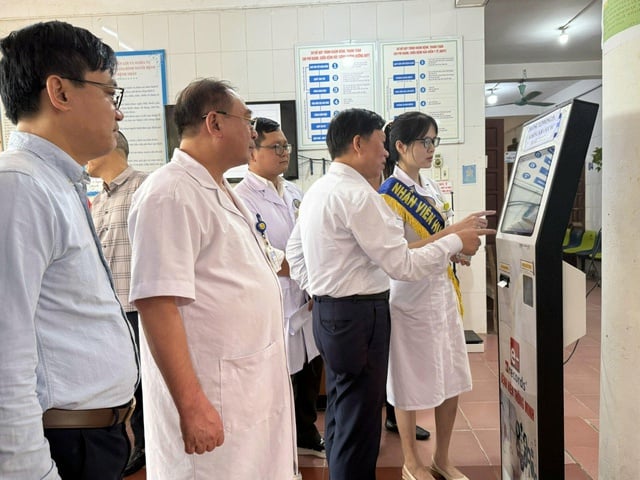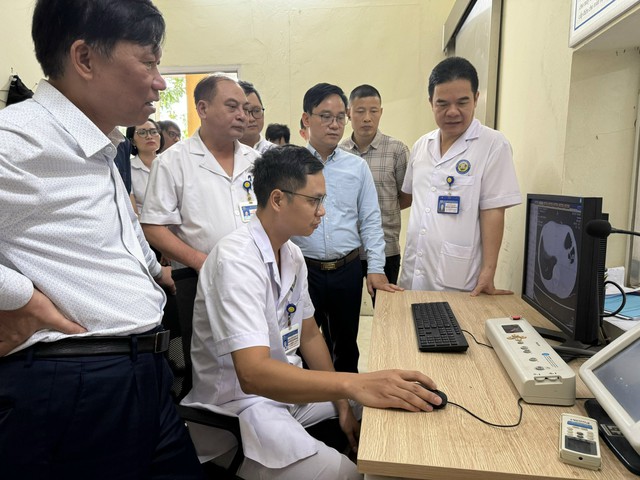
Hanoi has 100% of public hospitals implementing electronic medical records. Photo: VGP/Thien Tam
This is not only a technical step forward, but also a comprehensive transformation in the management and provision of medical services, bringing practical benefits to both patients and medical staff.
The development and implementation of electronic medical records is one of the key tasks of the Hanoi Health sector to implement the policy of promoting national digital transformation, especially the Project on developing applications of population data, identification and electronic authentication to serve digital transformation in the period 2022 - 2025, with a vision to 2030 of the Government .
The Hanoi Department of Health has proactively advised the City People's Committee to develop a plan to deploy electronic medical records throughout the area. The specific guidance and directive documents issued, along with the organization of conferences, training sessions, and signing of progress commitments, have clearly demonstrated the high determination of the industry in putting electronic medical records into practice.
During the implementation process, the Department of Health has organized many specialized conferences on digital transformation. At the Hanoi Health Sector Digital Transformation Conference 2025 with the theme "Electronic Medical Records - Comprehensive Connection, Creating a Digital Future" , hospitals signed a commitment on the progress of deploying electronic medical records. Next, the conference "Improving the efficiency and security of medical data" held in June 2025 at Phenikaa University Hospital also deployed Circular 13/2025/TT-BYT dated June 6, 2025 of the Ministry of Health on guidelines for deploying electronic medical records and specialized training on safety, network security and information security, personal data in the health sector.
Hospitals have proactively allocated resources, invested in hardware and software infrastructure, and synchronized information technology systems to ensure effective implementation of electronic medical records. This is a clear demonstration of the spirit of innovation and determination to complete the goals of the Capital Health Sector in applying information technology to digitally transform professional activities.
Electronic medical records replace traditional paper medical records, helping to manage medical data in a more scientific, accurate and comprehensive way. This system not only stores medical examination and treatment records of each patient but also connects and shares data between medical facilities, forming a modern medical information network.
For the medical team, electronic medical records help reduce administrative procedures, save time recording, searching and storing records. Instead of processing documents manually, doctors can quickly access the patient's entire medical history with just a few operations on the system. Thanks to that, diagnosis and treatment are more accurate, continuous and effective.
Electronic medical records provide centralized, unified data, helping the Department of Health and relevant agencies grasp the situation of medical examination and treatment, epidemiology, infectious diseases or public health issues quickly and promptly. This is an important basis for policy planning, strategy adjustment and appropriate resource allocation.
In addition, the implementation of electronic medical records also contributes significantly to the administrative reform of the health sector. All data is digitized, the medical examination and treatment process is streamlined and transparent, contributing to improving service quality and building trust from the people.
Proactive, flexible, practical

Electronic medical records also bring greater safety to patients. Photo: VGP/Thien Tam
Patients are the most direct and obvious beneficiaries of electronic medical records. With this system, patients' medical records are stored for life and are easily accessible when needed. This helps patients avoid having to carry a lot of documents and medical records every time they go to the hospital, reducing inconvenience during the medical examination and treatment process.
More importantly, information is fully stored and interconnected between hospitals, helping doctors have a comprehensive view of health status, medical history, and medications used. Thereby, limiting the situation of duplicate tests, inappropriate prescriptions, or inaccurate diagnoses.
Electronic medical records also provide greater safety for patients. Medical data is kept confidential according to regulations, minimizing the risk of loss or error as when using paper records. At the same time, patients can easily look up personal information, test results, medications, etc. through software applications.
In the context of digital society, when the need for online medical examination and treatment and online appointment booking is becoming more and more popular, electronic medical records will be the platform for patients to access medical services more intelligently, conveniently, quickly and safely.
Removing difficulties for effective implementation
However, the implementation of electronic medical records still faces difficulties and obstacles. For non-public hospitals, the implementation is still slow, the implementation rate is still low; the issue of technology infrastructure, investment costs, and training of IT human resources is also a big challenge. To date, 27/48 (56.2%) non-public hospitals have implemented electronic medical records.
The Hanoi Department of Health has proactively coordinated with the Ministry of Health and relevant agencies to resolve difficulties. Training conferences and in-depth guidance on information security, network security, and personal data security have been organized, helping hospitals improve their implementation capacity. In addition, propaganda work has also been promoted to change awareness and create consensus from medical staff to the people.
For units that have deployed electronic medical records, the Hanoi Department of Health requires them to continue completing the forms in accordance with the provisions of Circulars No. 25 and 26/2025/TT-BYT of the Ministry of Health. At the same time, medical facilities need to step up the completion of storage infrastructure; develop and promulgate regulations and procedures for storing medical records and documents according to the instructions in Circular No. 33/2025/TT-BYT of the Ministry of Health. Units also urgently complete the application for approval of information security levels according to Circular No. 12/2022/TT-BTTTT of the Ministry of Information and Communications (now the Ministry of Science and Technology). At the same time, hospitals must actively participate in connecting with the medical data coordination system in Hanoi, in order to ensure effective exploitation and synchronization of medical data throughout the system.
Completing the implementation of electronic medical records in 100% of public hospitals is an important milestone, but this is only the first step in the journey of digitalizing healthcare. In the coming time, the Hanoi Health sector aims to continue expanding the application of digital technology, moving towards managing the health of the entire population on a digital platform.
Connecting electronic medical records with national databases on population, health insurance, and social insurance will create a smart, interconnected, and modern healthcare ecosystem. At that time, each person will have a unique medical identification code, managing the entire medical examination and treatment history throughout their life.
At the same time, new technologies such as artificial intelligence (AI), big data analysis (Big Data), and the Internet of Things (IoT) in healthcare will be gradually applied, helping to predict and prevent diseases, optimize medical examination and treatment processes, and improve the quality of medical services.
Kindness
Source: https://baochinhphu.vn/100-benh-vien-cong-lap-cua-ha-noi-da-trien-khai-benh-an-dien-tu-103251001150750985.htm







![[Photo] Cat Ba - Green island paradise](/_next/image?url=https%3A%2F%2Fvphoto.vietnam.vn%2Fthumb%2F1200x675%2Fvietnam%2Fresource%2FIMAGE%2F2025%2F12%2F04%2F1764821844074_ndo_br_1-dcbthienduongxanh638-jpg.webp&w=3840&q=75)






























































































Comment (0)